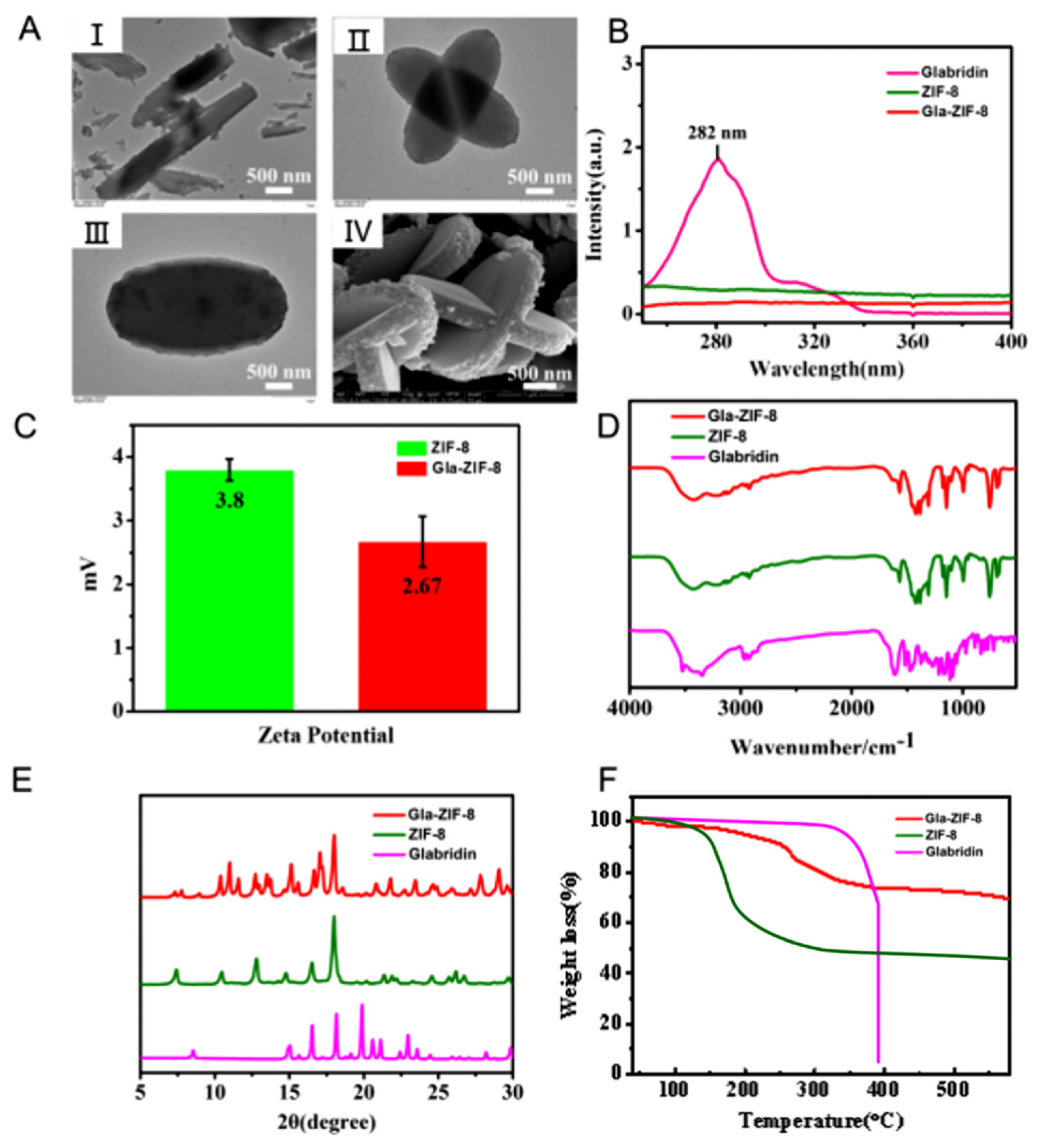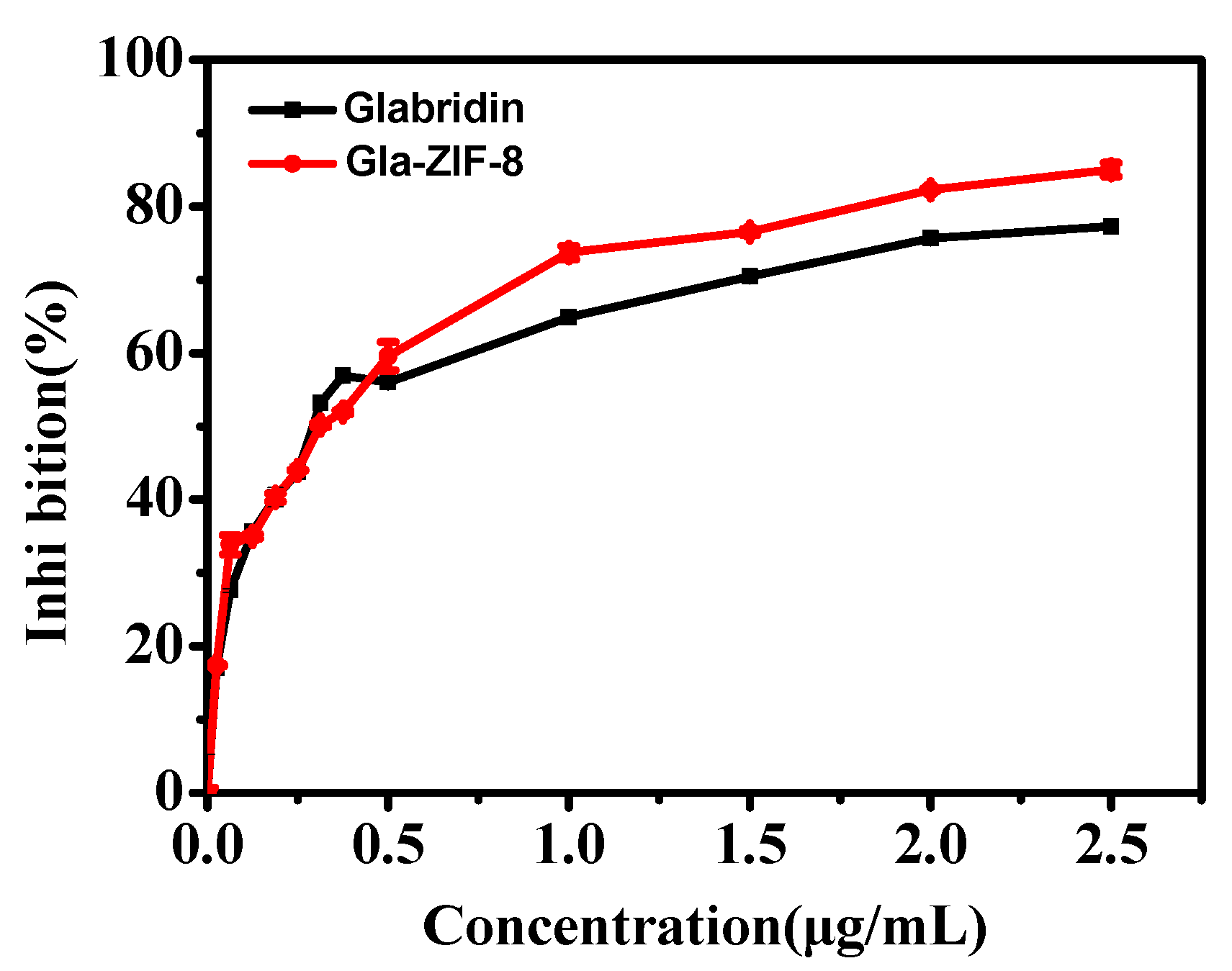Self-Assembled pH-Responsive Metal-Organic Frameworks for Enhancing the Encapsulation and Anti-Oxidation and Melanogenesis Inhibition Activities of Glabridin
Abstract
:1. Introduction
2. Results and Discussion
2.1. Preparation of Gla-ZIF-8
2.2. Encapsulation Efficiency of Gla-ZIF-8
2.3. Characterization of Gla-ZIF-8
2.4. In Vitro pH-Responsive Release of Glabridin from Gla-ZIF-8
2.5. Tyrosinase Inhibitory Activity
2.6. In Vitro Anti-Oxidant Activity of Gla-ZIF-8
2.7. Cellular Anti-Oxidant Activity
3. Materials and Methods
3.1. Materials
3.2. Analysis by Reverse-Phase High-Performance Liquid Chromatography
3.3. Preparation of Gla-ZIF-8
3.4. Characterization of Gla-ZIF-8
3.5. In Vitro Drug Release Behavior of Gla-ZIF-8
3.6. Tyrosinase Inhibitory Activity of Gla-ZIF-8
3.7. In Vitro Anti-Oxidant Activity
3.8. Cellular Anti-Oxidant Activity
3.9. Statistical Analysis
4. Conclusions
Author Contributions
Funding
Institutional Review Board Statement
Informed Consent Statement
Data Availability Statement
Conflicts of Interest
Sample Availability
References
- Simmler, C.; Pauli, G.F.; Chen, S.N. Phytochemistry and biological properties of glabridin. Fitoterapia 2013, 90, 160–184. [Google Scholar] [CrossRef] [PubMed] [Green Version]
- Asl, M.N.; Hosseinzadeh, H. Review of pharmacological effects of Glycyrrhiza sp. And its bioactive compounds. Phytother. Res. 2008, 22, 709–724. [Google Scholar] [CrossRef] [PubMed]
- Thiyagarajan, P.; Chandrasekaran, C.V.; Deepak, H.B.; Agarwal, A. Modulation of lipopolysaccharide-induced pro-inflammatory mediators by an extract of Glycyrrhiza glabra and its phytoconstituents. Inflammopharmacology 2011, 19, 235–241. [Google Scholar] [CrossRef] [PubMed]
- El-Ashmawy, N.E.; Khedr, N.F.; El-Bahrawy, H.A.; El-Adawy, S.A. Downregulation of iNOS and elevation of cAMP mediate the anti-inflammatory effect of glabridin in rats with ulcerative colitis. Inflammopharmacology 2018, 26, 551–559. [Google Scholar] [CrossRef] [PubMed]
- Falk, E. Pathogenesis of atherosclerosis. J. Am. Coll. Cardiol. 2006, 47, C7–C12. [Google Scholar] [CrossRef] [PubMed] [Green Version]
- Yu, X.; Xue, C.C.; Zhou, Z.; Li, C.; Du, Y.; Liang, J.; Zhou, S. In vitro and in vivo neuroprotective effect and mechanisms of glabridin, a major active isoflavan from Glycyrrhiza glabra (licorice). Life Sci. 2008, 82, 68–78. [Google Scholar] [CrossRef]
- Cristancho, A.G.; Lazar, M.A. Forming functional fat: A growing understanding of adipocyte differentiation. Nat. Rev. Mol. Cell Biol. 2011, 12, 722–734. [Google Scholar] [CrossRef]
- Lee, J.W.; Choe, S.S.; Jang, H.; Kim, J.; Jeong, H.W.; Jo, H.; Jeong, K.H.; Tadi, S.; Park, M.G.; Kwak, T.H.; et al. AMPK activation with glabridin ameliorates adiposity and lipid dysregulation in obesity. J. Lipid Res. 2012, 53, 1277–1286. [Google Scholar] [CrossRef] [Green Version]
- Wu, F.; Jin, Z.; Jin, J. Hypoglycemic effects of glabridin, a polyphenolic flavonoid from licorice, in an animal model of diabetes mellitus. Mol. Med. Rep. 2013, 7, 1278–1282. [Google Scholar] [CrossRef] [Green Version]
- Chen, K.G.; Sikic, B.I. Molecular pathways: Regulation and therapeutic implications of multidrug resistance. Clin. Cancer Res. 2012, 18, 1863–1869. [Google Scholar] [CrossRef] [Green Version]
- Tamir, S.; Eizenberg, M.; Somjen, D.; Stern, N.; Shelach, R.; Kaye, A.; Vaya, J. Estrogenic and antiproliferative properties of glabridin from licorice in human breast cancer cells. Cancer Res. 2000, 60, 5704–5709. [Google Scholar] [PubMed]
- Nerya, O.; Vaya, J.; Musa, R.; Izrael, S.; Ben-Arie, R.; Tamir, S. Glabrene and isoliquiritigenin as tyrosinase inhibitors from licorice roots. J. Agric. Food Chem. 2003, 51, 1201–1207. [Google Scholar] [CrossRef] [PubMed]
- Della-Cioppa, G.; Garger, S.J.; Sverlow, G.G.; Turpen, T.H.; Grill, L.K. Melanin production in Escherichia coli from a cloned tyrosinase gene. Biotechnology 1990, 8, 634–638. [Google Scholar] [CrossRef] [PubMed]
- Slominski, R.M.; Sarna, T.; Płonka, P.M.; Raman, C.; Brożyna, A.A.; Slominski, A.T. Melanoma, melanin, and melanogenesis: The yin and yang relationship. Front. Oncol. 2022, 12, 842496. [Google Scholar] [CrossRef] [PubMed]
- Gillbro, J.M.; Olsson, M.J. The melanogenesis and mechanisms of skin-lightening agents-existing and new approaches. Int. J. Cosmet. Sci. 2011, 33, 210–221. [Google Scholar] [CrossRef] [PubMed]
- Yokota, T.; Nishio, H.; Kubota, Y.; Mizoguchi, M. The inhibitory effect of glabridin from licorice extracts on melanogenesis and inflammation. Pigment. Cell Res. 1998, 11, 355–361. [Google Scholar] [CrossRef]
- Chen, J.; Yu, X.; Huang, Y. Inhibitory mechanisms of glabridin on tyrosinase. Spectrochim. Acta A Mol. Biomol. Spectrosc. 2016, 168, 111–117. [Google Scholar] [CrossRef]
- Yamauchi, K.; Mitsunaga, T.; Batubara, I. Isolation, Identification and Tyrosinase Inhibitory Activities of the Extractives from Allamanda cathartica. Nat. Resour. 2011, 2, 167–172. [Google Scholar] [CrossRef] [Green Version]
- Deshmukh, K.; Poddar, S.S. Tyrosinase inhibitor-loaded microsponge drug delivery system: New approach for hyperpigmentation disorders. J. Microencapsul. 2012, 29, 559–568. [Google Scholar] [CrossRef]
- Majeed, M.; Satyan, K.S.; Geetha, K.G.; Prakash, S. Novel Topical Skin Care and Nutraceutical Applications of Glabridin or Extracts Containing a Defined Amount (4–90%) of Glabridin. U.S. Patent US2004/0121031 A1, 24 July 2004. [Google Scholar]
- Beg, S.; Rahman, M.; Jain, A.; Saini, S.; Midoux, P.; Pichon, C.; Ahmad, F.J.; Akhter, S. Nanoporous metal organic frameworks as hybrid polymer-metal composites for drug delivery and biomedical applications. Drug Discov. Today 2017, 22, 625–637. [Google Scholar] [CrossRef]
- Chen, W.; Wu, C. Synthesis, functionalization, and applications of metal-organic frameworks in biomedicine. Dalton Trans. 2018, 47, 2114–2133. [Google Scholar] [CrossRef] [PubMed]
- Suib, S.L. A review of recent developments of mesoporous materials. Chem. Rec. 2017, 17, 1169–1183. [Google Scholar] [CrossRef] [PubMed]
- Abdelhamid, H.N. Zeolitic imidazolate frameworks (ZIF-8) for biomedical applications: A review. Curr. Med. Chem. 2021, 28, 7023–7075. [Google Scholar] [CrossRef] [PubMed]
- Zhang, H.; Jiang, W.; Liu, R.; Zhang, J.; Zhang, D.; Li, Z.; Luan, Y. Rational design of metal organic framework Nanocarrier-Based codelivery system of doxorubicin Hydrochloride/Verapamil hydrochloride for overcoming multidrug resistance with efficient targeted cancer therapy. ACS Appl. Mater. Interfaces 2017, 9, 19687–19697. [Google Scholar] [CrossRef] [PubMed]
- Yang, J.C.; Chen, Y.; Li, Y.H.; Yin, X.B. Magnetic resonance Imaging-Guided Multi-Drug chemotherapy and photothermal synergistic therapy with pH and NIR-Stimulation release. ACS Appl. Mater. Interfaces 2017, 9, 22278–22288. [Google Scholar] [CrossRef]
- Chen, X.; Tong, R.; Shi, Z.; Yang, B.; Liu, H.; Ding, S.; Wang, X.; Lei, Q.; Wu, J.; Fang, W. MOF nanoparticles with encapsulated autophagy inhibitor in controlled drug delivery system for antitumor. ACS Appl. Mater. Interfaces 2018, 10, 2328–2337. [Google Scholar] [CrossRef]
- Gomar, M.; Yeganegi, S. Adsorption of 5-fluorouracil, hydroxyurea and mercaptopurine drugs on zeolitic imidazolate frameworks (ZIF-7, ZIF-8 and ZIF-9). Microporous Mesoporous Mater. Off. J. Int. Zeolite Assoc. 2017, 252, 167–172. [Google Scholar] [CrossRef]
- Zhuang, J.; Kuo, C.H.; Chou, L.Y.; Liu, D.Y.; Weerapana, E.; Tsung, C.K. Optimized metal-organic-framework nanospheres for drug delivery: Evaluation of small-molecule encapsulation. ACS Nano 2014, 8, 2812–2819. [Google Scholar] [CrossRef]
- Liedana, N.; Galve, A.; Rubio, C.; Tellez, C.; Coronas, J. CAF@ZIF-8: One-step encapsulation of caffeine in MOF. ACS Appl. Mater. Interfaces 2012, 4, 5016–5021. [Google Scholar] [CrossRef]
- Vasconcelos, I.B.; Silva, T.G.D.; Militão, G.C.G.; Soares, T.A.; Rodrigues, N.M.; Rodrigues, M.O.; Costa, N.B.D.; Freire, R.O.; Junior, S.A. Cytotoxicity and slow release of the anti-cancer drug doxorubicin from ZIF-8. RSC Adv. 2012, 2, 9437. [Google Scholar] [CrossRef]
- Liu, Z.; Wu, Q.; He, J.; Vriesekoop, F.; Liang, H. Crystal-Seeded growth of pH-Responsive Metal-Organic frameworks for enhancing encapsulation, stability, and bioactivity of hydrophobicity compounds. ACS Biomater. Sci. Eng. 2019, 5, 6581–6589. [Google Scholar] [CrossRef] [PubMed]
- Fan, Y.; Liu, Y.; Gao, L.; Zhang, Y.; Yi, J. Improved chemical stability and cellular antioxidant activity of resveratrol in zein nanoparticle with bovine serum albumin-caffeic acid conjugate. Food Chem. 2018, 261, 283–291. [Google Scholar] [CrossRef] [PubMed]
- Wolfe, K.L.; Liu, R.H. Cellular antioxidant activity (CAA) assay for assessing antioxidants, foods, and dietary supplements. J. Agric. Food Chem. 2007, 55, 8896–8907. [Google Scholar] [CrossRef] [PubMed]
- Xiao-Dan, Z.; Yi, X.U.; Tao, Z.; Jun-Jiang, L.Ü. Assessing plant antioxidants by cellular antioxidant activity assay based on microfluidic cell chip with arrayed microchannels. Chin. J. Anal. Chem. 2016, 44, 604–609. [Google Scholar]
- Wei, Y.; Zhang, J.; Zhou, Y.; Bei, W.; Li, Y.; Yuan, Q.; Liang, H. Characterization of glabridin/hydroxypropyl-beta-cyclodextrin inclusion complex with robust solubility and enhanced bioactivity. Carbohydr. Polym. 2017, 159, 152–160. [Google Scholar] [CrossRef]






Publisher’s Note: MDPI stays neutral with regard to jurisdictional claims in published maps and institutional affiliations. |
© 2022 by the authors. Licensee MDPI, Basel, Switzerland. This article is an open access article distributed under the terms and conditions of the Creative Commons Attribution (CC BY) license (https://creativecommons.org/licenses/by/4.0/).
Share and Cite
Chen, L.; Liu, Z.; Zhao, X.; Liu, L.; Xin, X.; Liang, H. Self-Assembled pH-Responsive Metal-Organic Frameworks for Enhancing the Encapsulation and Anti-Oxidation and Melanogenesis Inhibition Activities of Glabridin. Molecules 2022, 27, 3908. https://doi.org/10.3390/molecules27123908
Chen L, Liu Z, Zhao X, Liu L, Xin X, Liang H. Self-Assembled pH-Responsive Metal-Organic Frameworks for Enhancing the Encapsulation and Anti-Oxidation and Melanogenesis Inhibition Activities of Glabridin. Molecules. 2022; 27(12):3908. https://doi.org/10.3390/molecules27123908
Chicago/Turabian StyleChen, Liang, Zexun Liu, Xinying Zhao, Linying Liu, Xiulan Xin, and Hao Liang. 2022. "Self-Assembled pH-Responsive Metal-Organic Frameworks for Enhancing the Encapsulation and Anti-Oxidation and Melanogenesis Inhibition Activities of Glabridin" Molecules 27, no. 12: 3908. https://doi.org/10.3390/molecules27123908
APA StyleChen, L., Liu, Z., Zhao, X., Liu, L., Xin, X., & Liang, H. (2022). Self-Assembled pH-Responsive Metal-Organic Frameworks for Enhancing the Encapsulation and Anti-Oxidation and Melanogenesis Inhibition Activities of Glabridin. Molecules, 27(12), 3908. https://doi.org/10.3390/molecules27123908





